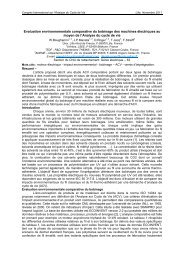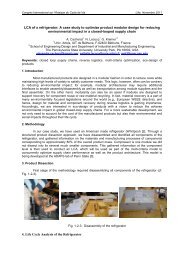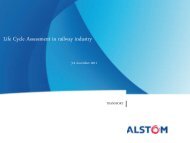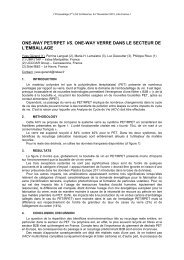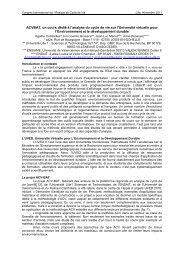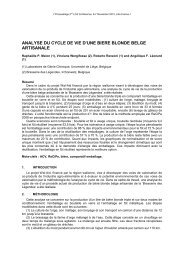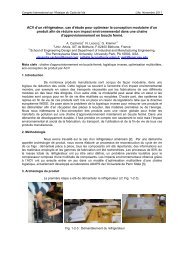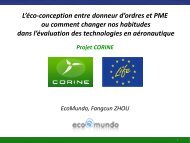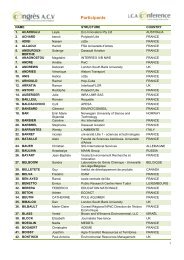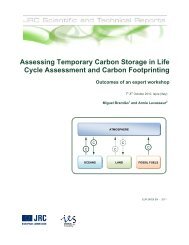Untitled - avniR
Untitled - avniR
Untitled - avniR
You also want an ePaper? Increase the reach of your titles
YUMPU automatically turns print PDFs into web optimized ePapers that Google loves.
Congrès International sur l’Analyse du Cycle de Vie Lille, Novembre 2011<br />
Apparel: complexity of a sector<br />
How to choose the best life cycle scenario?<br />
Inès BOUFATEH* , **, Anne PERWUELZ* , **, Besoa RABENASOLO* , ***, Anne-Marie Jolly-Desodt****<br />
*Univ Lille Nord de France, F-59000 Lille, France<br />
**ENSAIT - GEMTEX, F-59056 Roubaix, France<br />
*** Ecole Centrale de Lille - LM²O, F-59651 Villeneuve d’Ascq France<br />
****Institut Prisme - Polytech Orléans, 8 rue Leonard de Vinci, 45072 Orléans Cedex2, France<br />
ines.boufateh@ensait.fr; anne.perwuelz@ensait.fr; besoa.rabenasolo@ensait.fr;<br />
anne-marie.jolly@univ-orleans.fr<br />
Keywords: LCA, scenarios, MultiCriteria Decision Aid (MCDA), apparel industry.<br />
Background<br />
The textile apparel is a simple product: a T-shirt, for example, is made of two components that are<br />
knitted fabric and sewing thread. However, this product comes from a very complex industry. Indeed, a<br />
multitude of materials, manufacturing scenarios and supply chain strategies exist for the same product,<br />
which generates hundreds of production scenarios. Diversity of consumer behavior in use and end of life<br />
phases increases more the number of possible scenarios for the product life cycle. Consequently, the<br />
environmental impact assessment of textiles scenarios is complex. The decision in choosing the best<br />
environmental profile is conflictual. Authors’ objective consists in aiding to highlight answers to these<br />
questions: “how to make the interpretation of LCA results easier in order to identify the good trade-off of<br />
scenarios minimizing the environmental impacts of textiles life cycles?”<br />
Life Cycle Assessment in the textile field<br />
The textile industry is composed of several different activities. In addition to this diversity, the<br />
textile field is also characterized by the variety of raw materials from agriculture, chemical and oil industry.<br />
The textile processes such as fibres preparation, spinning, knitting or weaving, pre-treatments, dyeing,<br />
finishing, garment making and packaging are also quite varied. Therefore, the modelling of “what if”<br />
scenarios in Life Cycle Assessment is complex. Indeed, even the product is simple such as a cotton T-<br />
shirt, the number of possible manufacturing scenarios is huge. If we consider the diversity in cotton fibres’<br />
origins (type of agriculture) and in processes of spinning, knitting, pre-treatments, dyeing and finishing, 720<br />
scenarios should be modelled [1]. In addition to the large number of possible scenarios for the same<br />
product, interpreting textile LCA results is quite complex. In order to illustrate this complexity through a<br />
simple example, four scenarios of a T-shirt life cycle are modelled with changing fibres and adequate<br />
processes for each.<br />
FIG. 1 – Comparison of life cycle scenarios of cotton, lyocell, viscose and polyester T-shirts with<br />
normalization on cotton scenario<br />
FIG. 1 shows that the cotton T-shirt is the best at three environmental impacts: acidification (ADP),<br />
marine aquatic ecotoxicity (MAETP) and photochemical ozone creation (POCP) potentials. If we compare<br />
it to polyester scénario, it is worse at eutrophication (EP), fresh water aquatic ecotoxicity (FAETP), human<br />
toxicity (HTP), ozone layer depletion (ODP) and terrestrial ecotoxicity potentials (TETP). This analysis<br />
does not allow us to make judgment for cotton and polyester scenarios according to their eco-profiles since<br />
we do not have sufficient knowledge about the weightiness of each impact.<br />
In order to compare and to rank life cycle scenarios according to their eco-profiles, the need to<br />
apply a multicriteria decision aid (MCDA) method increases with the number of assessed scenarios.<br />
57



